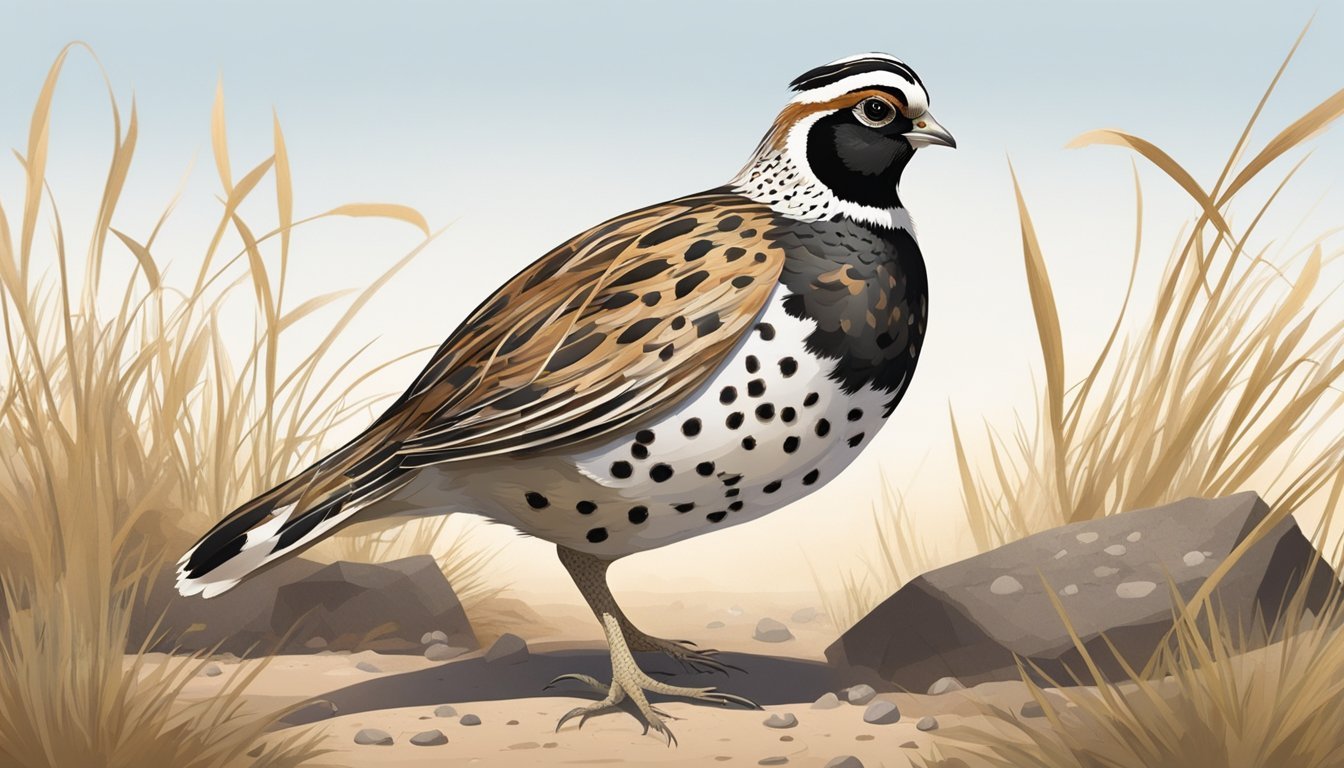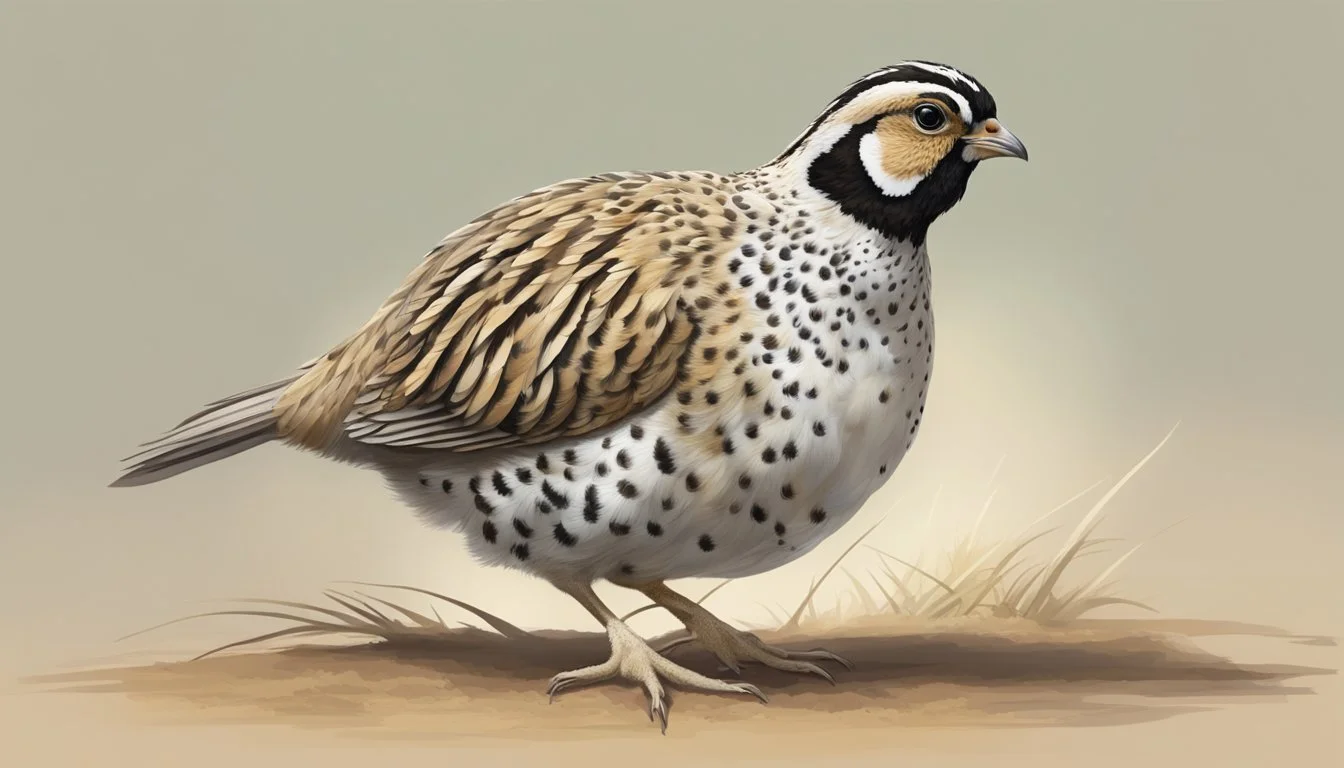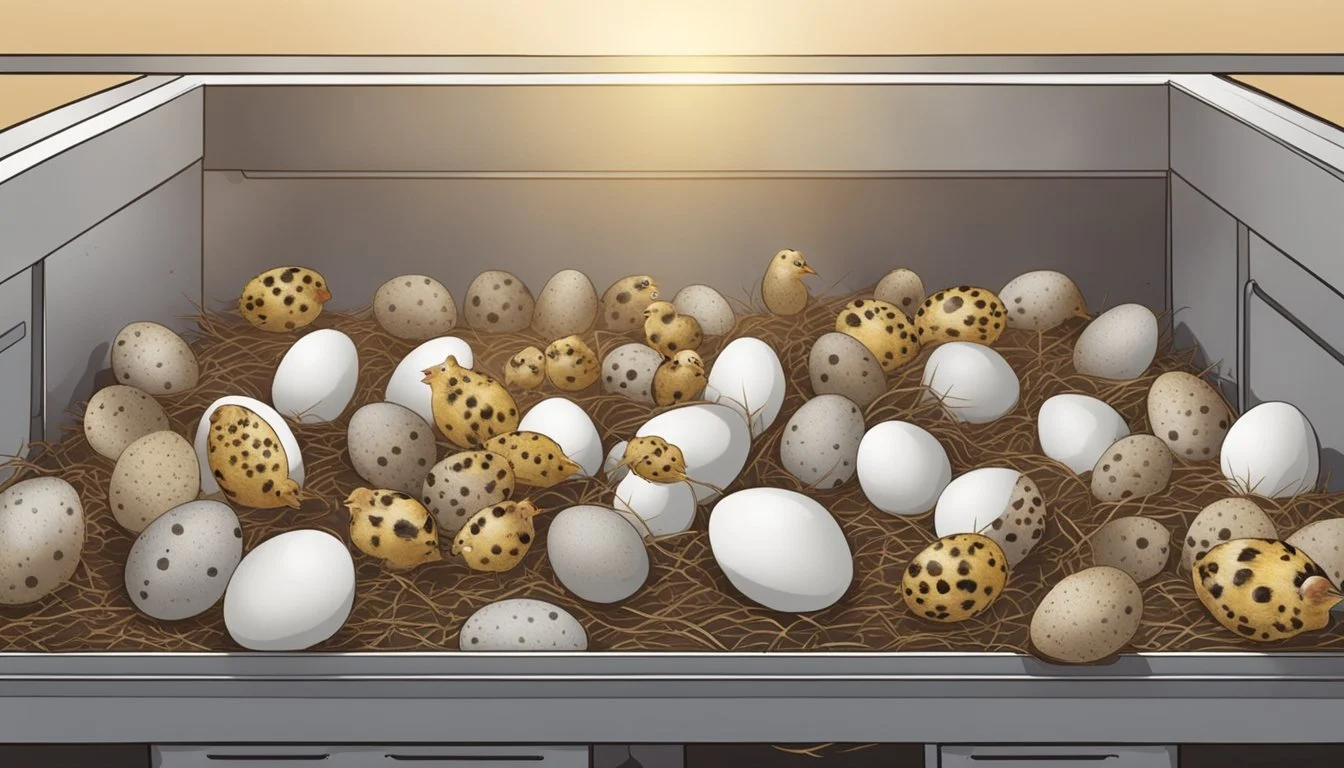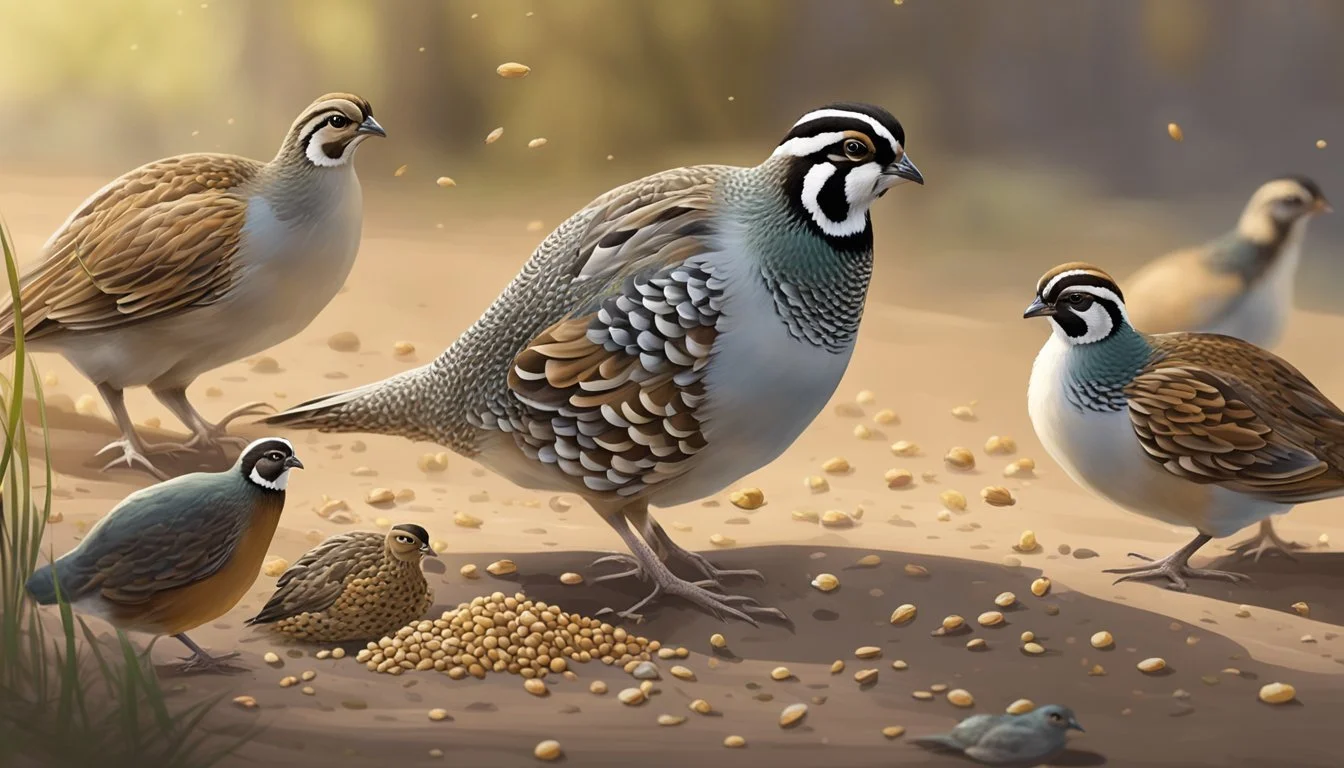Coturnix Quail
Comprehensive Care and Breeding Guide
Coturnix quail (What wine goes well with quail?), also known as Japanese quail, are small, attractive birds that have gained popularity for their ease of care and versatile use. These quails are native to East Asia and are considered to be the most commonly domesticated species of quail. They are primarily raised for their delightful companionship, nutritious eggs, and tender meat, making them an excellent addition to small farms or backyard homesteads.
The Coturnix quail is a tough and flexible bird, thriving in various places, be it in the countryside or city. Their small size, calm demeanor, and quiet behavior make them perfect for folks with not much space or anyone looking for a low-key option for bigger birds like chickens. Adding to their charm, Coturnix quail is a breeze to raise, laying lots of eggs relatively quickly compared to other poultry. For optimal care, consider using supplemental lighting to ensure they get enough hours of light, maintain clean water, and keep an eye on the ambient and air temperatures to avoid any color variations or variety in their plumage.
In addition to their practical uses, Coturnix quail exhibits an array of attractive physical features and engaging social behavior, capturing the interest of bird enthusiasts and hobbyists. Their distinctive plumage can vary between individuals, creating a captivating display of patterns and colors. Their charm and adaptability continue to endear them to those who raise them, solidifying their place in the hearts of many as a beloved farmyard and backyard companion.
History and Origin of Coturnix Quail
The Coturnix quail, also known as the Japanese quail or Old World quail, is a small bird species native to a large region encompassing Asia and Europe. Initially, these quails were valued for their song, and decorative properties, and later became popular for their meat and eggs.
Coturnix Quail in Japan
In Japan, the Coturnix quail has a long history, with evidence of domestication dating back to at least the 12th century. The Japanese highly prized their song and considered them as pets, a tradition that persisted through the Edo period (1603-1868).
Here are some quick facts about the Japanese quail:
Scientific name: Coturnix japonica
Native range: Eastern Asia, particularly Japan
Domestication: From the 12th century in Japan
Uses: Pets for their song, meat, and eggs
During the early to mid-20th century, selective breeding programs were introduced in Japan, resulting in specialized quail lines. These lines were bred for different purposes such as improved laying rates for egg production and enhanced growth rates for meat consumption.
Spread to Other Regions
As the coturnix quail gained popularity, it began to spread to other regions across Asia and eventually made its way to Europe and North America. The birds have proven to be highly adaptable to various environments, both in the wild and in captivity.
The subsequent table highlights key events in the spread of the Coturnix quail:
Period: Late 19th to early 20th century
Region: Europe
Detail: Introduction of Japanese quail for aviculture and ornamental purposes
Period: 1950s
Region: Europe, North America
Detail: Introduction for scientific research, particularly genetics and embryology
Period: 1960s–70s
Region: North America
Detail: Expansion of breeding for meat and egg production
The Coturnix quail's global significance has increased over the years, with the bird now commonly bred for various purposes. Their adaptability, high reproductive rates, and relatively low maintenance make them an appealing option for small-scale hobbyists as well as large-scale commercial operations.
Characteristics of Coturnix Quail
Physical Description
Coturnix quail, also known as Japanese quail, are relatively small birds with various sizes and plumage patterns. Their average size ranges from 7 to 10 inches in length and 3 to 6 ounces in weight. These birds have a compact body shape with a short beak, rounded wings, and a small tail.
The plumage of Coturnix quail covers a wide range of colors and patterns, such as solid, spotted, and speckled. Common colorations include tuxedo (black and white), English white (almost completely white), and various shades of browns and grays.
Varieties of Coturnix Quail
There are several varieties of Coturnix quail, each differing slightly in size and appearance:
Japanese Coturnix: This is the most common variety of Coturnix quail. They have a relatively small size and a variety of plumage patterns, and they're known for their adaptability and hardiness.
Jumbo Coturnix: As the name suggests, the Jumbo Coturnix is larger than the standard Japanese variety. These birds can weigh up to 14 ounces and usually display a range of brown, gray, and tuxedo plumage patterns.
Tuxedo Coturnix: The Tuxedo Coturnix is characterized by its distinctive black and white plumage. This attractive variation is mostly bred for ornamental purposes, while still maintaining the compact size of the standard Coturnix quail.
English White Coturnix: The English White Coturnix is another visually striking variety. These birds are almost entirely white, with only a few brown or black markings, mainly around their eyes. They are slightly larger than the Japanese Coturnix but smaller than the Jumbo Coturnix.
Coturnix Quail as Livestock
Egg Production
Coturnix quail are prolific egg layers, with a laying rate of about one egg per day. Their egg production typically begins around the age of 6-8 weeks, and they can lay eggs fairly consistently up to 1.5-2 years. In terms of egg size, Coturnix quail eggs are small compared to a chicken egg but larger than other quail species, such as the Bobwhite quail. One Coturnix quail egg weighs approximately 10 grams.
The eggs have a firm texture and a mild flavor, making them suitable for various culinary uses. Coturnix quail eggs are also considered a healthy protein source, as they have a low saturated fat content and contain essential vitamins and minerals.
Meat Production
Coturnix quail are compact birds raised for their meat, which is lean, tender, and high in protein. The Jumbo Coturnix quail, a larger variety of the species, is particularly sought after for meat production. Jumbo Coturnix quail reaches maturity quickly, typically in only 6-8 weeks, and can be harvested for meat at that time.
Below is a comparison of Coturnix quail and other common meat birds:
Coturnix Quail
Harvest Age (weeks): 6-8
Average Dressing Weight (grams): 150-300
Jumbo Coturnix Quail
Harvest Age (weeks): 6-8
Average Dressing Weight (grams): 250-450
Chicken
Harvest Age (weeks): 17-20
Average Dressing Weight (grams): 2,000-3,000
Cornish Cross
Harvest Age (weeks): 6-8
Average Dressing Weight (grams): 1,500-2,200
In addition, Coturnix quail meat can be easily sold in niche markets, and it is recognized for its nutritional benefits. The meat is known to contain a substantial amount of healthy omega-3 fatty acids, which can be advantageous for maintaining optimal heart health.
Breeding and Hatching
Incubation Process
To begin breeding Coturnix quail, fertile eggs are essential. These eggs can be obtained through a reliable supplier or by housing a compatible male and female ratio in a suitable environment. The optimal ratio is usually one male for every three to five females. The incubation process commences once the eggs are placed in an incubator with specific temperature and humidity settings.
Temperature (°F): 99.5
Humidity (%): 45-55
Duration (Days): 14-15
During the incubation process, it is important to maintain the temperature consistently and oversee the moisture levels periodically. Eggs should be turned three times a day, either manually or with automated assistance. On the final days of incubation, cease turning the eggs and increase the humidity by 65-75% to initiate the hatching process.
Note: Coturnix quail eggs generally begin to hatch around 17-18 days.
Raising Young Quail
When it comes to raising young quail, providing the right conditions is key. For quail chicks, especially the common and domestic varieties kept for eggs, using a heat lamp is crucial to ensure they stay warm. Supplemental heat is essential during their early days, and maintaining the right ambient temperature is important for their well-being and proper feather development.
For successful quail farming, it's advisable to monitor the light per day, as this affects their growth and egg-laying. When collecting eggs, be sure to observe any color variety, as it could indicate the health and diet of the quail. By paying attention to these details, you'll contribute to the overall well-being and productivity of your quail flock.
Once the hatching eggs crack, refrain from helping the chicks unless it's necessary to assist. Chicks must be allowed to hatch independently, and any interference may impede their development. After they have fully emerged and dried, place them in a pre-heated brooder with a temperature ranging from 95-100°F.
In the first week, adapt the chicks' diet to a game bird starter feed with 24-28% protein.
Gradually decrease the temperature of the brooder each week by 5°F until the chicks are acclimatized to their new environment.
Ensure that plenty of fresh water is provided, which can be achieved by utilizing shallow dishes or chick waterers.
As they grow, the young quail will begin to exhibit adult characteristics, signifying their maturity. At the tender age of around six to eight weeks, they can be released from the brooder and, depending on their purpose, placed into a laying pen or grow-out pen.
Feeding and Nutrition
Diet Requirements
Coturnix quails have a varied diet to ensure their optimal growth and well-being. Their diet mainly consists of grains, seeds, insects, and plant materials. Young chicks require a diet high in protein, around 28% to encourage rapid growth and proper development. Adult quails, however, thrive on a slightly lower protein diet, ranging from 16% to 18%.
Grains such as millet, wheat, and corn can be fed to quails as a staple food. Seeds like sunflower and safflower are also great sources of nutrition. Quails have a natural appetite for insects such as mealworms and crickets, which provide essential proteins and minerals.
Additionally, supplementing their diet with vitamins and minerals, especially calcium, is important for egg production. This can be achieved by providing a source of calcium, such as crushed oyster shells or limestone grit.
Water Needs
Proper hydration is essential for the health and well-being of Coturnix quails. Clean, fresh water should always be readily available to them. Quail drinks a considerable amount of water, about half of the amount of food consumed daily. The following table outlines the approximate daily water intake for quails based on their age:
Age of Quail: 1-7 days
Daily Water Intake: 1.5 - 2 ml
Age of Quail: 8-14 days
Daily Water Intake : 3 - 3.5 ml
Age of Quail: 15-21 days
Daily Water Intake: 3.5 - 4.5 ml
Age of Quail: 22-28 days
Daily Water Intake : 4 - 6 ml
Age of Quail: Over 28 days
Daily Water Intake : 6 - 8 ml
It's essential to monitor water levels consistently and adjust as needed. Providing multiple sources of water ensures that quails have access even if one source becomes empty or contaminated. Ensure that waterers are clean and free from debris before refilling them, as dirty water can lead to diseases.
By attending to their dietary requirements and water needs, Coturnix quail can be healthy and productive birds. A well-balanced diet including grains, seeds, insects, vitamin and mineral supplements, and access to fresh water, ensures that quails can thrive and reach their full potential.
Housing and Space Requirements
Coop and Pen Design
When it comes to meeting the basic requirements for housing Coturnix quail, the coop and pen design is crucial for their safety and welfare. A well-designed coop should primarily offer protection against predators, such as snakes, rats, and larger birds. Using a fine wire mesh for the coop and pen enclosure is essential, as this prevents intrusion from predators while maintaining proper air circulation.
When creating a Coturnix quail coop for egg collection, it is important to keep in mind the needs of both common quail and domestic quail. The coop should be designed with an indoor and outdoor area. The indoor area can be a simple wooden box for resting, laying eggs and retreating from harsh weather. It is essential to ensure that the coop has a slanted or waterproof roof to prevent water from pooling. The outdoor pen area should provide ample space for quail to forage, stretch their legs, and dust-bathe.
Essential elements to include in a coop:
Sleeping quarters
Nesting boxes
Perches
Ventilation holes
Space Efficiency
Coturnix quail are birds that can adapt to small spaces and do not require excessive room like other poultry. Providing enough space for them to move comfortably is essential, as overcrowding can lead to aggressive behavior, stress, and potential disease outbreaks.
These are the general space requirements for Coturnix quail:
Age/Size Indoor Space (per bird) Outdoor Space (per bird) Chicks 1 square foot N/A Adults 2-3 square feet 3-4 square feet
While an adult quail usually needs 2-3 square feet of indoor space per bird, providing additional space will further improve their quality of life. Ground cover, like sand, leaves, or peat moss, should be provided in the outdoor pen area for dust-bathing, and this needs to be periodically replaced to maintain cleanliness.
In summary, when designing housing and pen areas for Coturnix quail, prioritize their safety, well-being, and space efficiency. A properly designed environment allows for happy, healthy birds and better chances for successful breeding and egg production.
Health and Disease Management
Common Health Issues
Coturnix quail are generally healthy and hardy birds, but they can still be susceptible to various health issues. Some common problems include:
Parasites: Quail can be infected by both internal and external parasites, such as worms, mites, and lice.
Respiratory diseases: Quail can develop respiratory problems, typically caused by bacterial or viral infections.
Stress: Quail can become stressed due to environmental factors, such as overcrowding and poor sanitation.
Preventative Measures
To minimize the risk of disease and maintain the health of your coturnix quail, implement the following preventative measures:
Hygiene: Maintain a clean and sanitary environment for your quail by regularly cleaning their housing and removing any accumulated waste.
Spacious housing: Provide adequate space for your quail, following the recommended stocking density guidelines.
Proper nutrition: Feed your quail a well-balanced diet, supplemented with vitamins and minerals when necessary.
Temperature control: Ensure the temperature in your quail's housing remains within the recommended range, helping to reduce stress and prevent heat-related issues.
Disease monitoring: Regularly check your quail for any signs of health issues and consult a veterinarian if you suspect any problems.
By following these guidelines and being vigilant about your quail's health, they can lead a healthy and productive life, providing you with a delicious and nutritious delicacy.
Behavioral Traits
Social Structure
Coturnix quail exhibit a social hierarchy within their groups, which typically consist of one male and several females, known as hens. The male quail is responsible for protecting the territory and the hens within it. Within this structure, dominance plays a significant role in shaping the behavior of individual quail.
Males: They often display aggressive behavior toward other males to assert their dominance and maintain their position within the group. This can include pecking, chasing, or physically attacking other males.
Females: Similarly, female quail also establish a hierarchical order among themselves. The dominant hen usually has priority access to food and other resources.
Flight and Noise
When it comes to flight and noise, Coturnix quail exhibit some unique characteristics:
Flight: Coturnix quail are known for their short and explosive flights. They prefer staying close to the ground, utilizing their strong legs to make quick and agile movements. This enables them to escape potential predators with ease.
Noise: Surprisingly, these quail are relatively quiet birds compared to other species. The males produce a series of low-pitched, rhythmic noises to attract hens and assert their dominance. On the other hand, hens communicate with each other through soft and subtle clucking sounds.
Male
Noise: Low-pitched, rhythmic
Female
Noise: Soft, subtle clucks
Coturnix quail displays distinct behavioral traits in terms of social structure, flight, and noise. Their complex hierarchical interactions and relatively quiet nature make them fascinating subjects for further study and observation.
Raising Coturnix Quail in Urban Settings
Legal Considerations
Before starting a quail venture in an urban environment, it is vital to research the local regulations and obtain any necessary permits. Laws regarding the keeping of quail vary greatly from city to city, and it is important to be aware of these restrictions to avoid penalties. Common requirements include:
Permit application: Check with your city's zoning department or animal control office.
Housing restrictions: Many cities have setback rules that dictate the distance between the quail's enclosure and structures on the property, such as the primary residence.
Noise ordinances: Coturnix quail are generally quiet birds, but it is still necessary to adhere to local noise laws.
Space Adaptations
When raising Coturnix quail in a limited urban space, homesteaders have to be creative in adapting their setup. Here are some recommendations to make the most of your available space:
Vertical space utilization: Maximize the use of vertical space with stacked cages or hutches. Ensure proper ventilation and ease of cleaning when designing vertical enclosures.
Adapting enclosures: Convert unused spaces in your backyard, such as repurposing a shed, dog kennel, or small greenhouse, to house your quail. Be sure to provide ample lighting and predator protection.
Brooder placement: Consider placing the brooder indoors or in a well-insulated structure to maintain adequate temperature and protect chicks from extreme weather conditions.
Space Requirement: Indoor Brooder
Size: 0.25–0.5 sq. ft.
Age: 1–4 weeks
Space Requirement: Outdoor Pen
Size: 1.0–2.0 sq. ft.
Age: 4+ weeks
Quail are well-suited to urban environments due to their small size and low noise levels. By adhering to local regulations and adapting enclosures to suit available space, city-dwelling homesteaders can successfully raise Coturnix quail in their backyards.
Use of Coturnix Quail Products
Consumption of Quail Eggs and Meat
Coturnix quail products, such as eggs and meat, are popular worldwide for their nutritional benefits and unique taste. Quail eggs are small, with a distinct flavor that many people find to be a pleasant alternative to traditional chicken eggs. They are rich in protein, vitamins, and minerals, making them a nutritious addition to any diet.
The consumption of quail meat is also on the rise. This lean protein source is known to be tender and flavorful, making it a popular choice for various culinary dishes. Quail meat is lower in calories and fat compared to beef or chicken, yet it contains essential nutrients like iron and vitamin B12. Below is a brief comparison of quail and chicken eggs' nutritional content:
Protein
Quail Egg: 11g
Chicken Egg: 13g
Fat
Quail Egg: 11g
Chicken Egg: 10g
Cholesterol
Quail Egg: 844mg
Chicken Egg: 425mg
While quail eggs have slightly less protein, they contain more cholesterol than chicken eggs. It is important to note that this cholesterol is considered as "good" cholesterol, which is beneficial for heart health.
Quail Eggs as a Delicacy
Apart from their nutritional benefits, quail eggs are often seen as a delicacy in many cultural cuisines. They are frequently used in fine dining, where their unique flavor and presentation add an exquisite touch to dishes. Some popular ways to use quail eggs in gourmet cooking include:
Soft-boiled: Served as appetizers or garnish, soft-boiled quail eggs have a delicate texture and rich taste that pair well with various dishes.
Pickled: Preserved in vinegar and spices, pickled quail eggs make an excellent addition to salads, antipasti, or as a standalone snack.
Deviled: An upscale version of the classic deviled egg, quail eggs are filled with a creamy, seasoned yolk mixture and often topped with high-quality ingredients like caviar or truffle.
Sushi: Nigiri or maki rolls featuring quail eggs are unique and delicious, offering a silky texture and mild flavor that complements the other ingredients.
Coturnix quail products have a wide range of uses in both daily consumption and fine-dining experiences. Rich in nutrients and boasting a unique flavor profile, they truly deserve their place at the table.
Comparison With Other Poultry
Coturnix Quail vs Chickens
Coturnix quail and chickens are both popular choices for poultry enthusiasts and homesteaders. However, there are some key differences to consider. Coturnix quail are notably smaller than chickens, making them an attractive choice for those with limited space. They are generally easier to care for and can be housed in smaller enclosures than chickens.
Size:
Coturnix Quail: Small
Chickens: Larger
Space Required:
Coturnix Quail: Less
Chickens: More
Noise:
Coturnix Quail: Low
Chickens: Moderate (especially with roosters)
Egg Production:
Coturnix Quail: High
Chickens: Moderate
Coturnix quail is also less noisy compared to chickens, especially considering the louder calls of roosters. This can be especially beneficial in urban or suburban settings where noise might be a concern. Additionally, quail reaches maturity and starts producing eggs earlier than chickens. They usually start laying eggs at 6-8 weeks of age, as compared to 20-24 weeks for most chicken breeds.
Benefits of Small-Scale Poultry
There are several benefits to raising small-scale poultry, like coturnix quail, on a homestead:
Space Efficiency: Small birds require less space, making them suitable for backyard or urban homesteads.
Low Maintenance: Coturnix quail are relatively easy to care for given their minimal space and feeding requirements. They also show great resistance to diseases compared to chickens.
Egg Production: These small birds are prolific layers, providing a regular supply of fresh eggs.
Fast Maturity: Coturnix quail mature quickly and have shorter generation times than chickens, making it easier to establish a breeding population.
Coturnix quail offers a unique and manageable option for small-scale poultry enthusiasts looking to enjoy the benefits of fresh eggs and a manageable homestead presence without the challenges that larger poultry like chickens might bring. Their size, efficiency, and lower noise levels make them an attractive choice.








